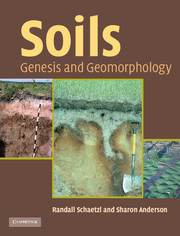Book contents
- Frontmatter
- Contents
- Preface
- Acknowledgements
- Part I The building blocks of the soil
- 1 Introduction
- 2 Basic concepts: soil morphology
- 3 Basic concepts: soil horizonation … the alphabet of soils
- 4 Basic concepts: soil mineralogy
- 5 Basic concepts: soil physics
- 6 Basic concepts: soil organisms
- 7 Soil classification, mapping and maps
- Part II Soil genesis: from parent material to soil
- Part III Soil geomorphology
- References
- Glossary
- Index
7 - Soil classification, mapping and maps
from Part I - The building blocks of the soil
- Frontmatter
- Contents
- Preface
- Acknowledgements
- Part I The building blocks of the soil
- 1 Introduction
- 2 Basic concepts: soil morphology
- 3 Basic concepts: soil horizonation … the alphabet of soils
- 4 Basic concepts: soil mineralogy
- 5 Basic concepts: soil physics
- 6 Basic concepts: soil organisms
- 7 Soil classification, mapping and maps
- Part II Soil genesis: from parent material to soil
- Part III Soil geomorphology
- References
- Glossary
- Index
Summary
The essence of any classification is to place a name on an definable entity, in this case a basic soil unit. Once this is done, it is possible to arrange them in an orderly system and establish interrelationships among them (Beckmann 1984). Most importantly, though, it allows for communication about the entities being classified.
Users of classification schemes agree that a name should carry with it a unique and defined range of characteristics, whether it be a plant (e.g., Pinus sylvestris), rock (e.g., arkose sandstone), or soil (e.g., a Lithic Fragiaquept). For soils, that range of characteristics may involve physical properties such as clay content of the B horizon, thickness of the A horizon, or color, among others. Over time, these ranges are changed as new and more complete information about the universe of soils (or plants or rocks) accrues. Thus, most classification systems are open-ended, and easily amended.
Before we try to classify a soil, we must first define it. We agree with Johnson (1998a), who defined soil as organic or lithic material at the surface of planets and similar bodies that has been altered by biological, chemical and/or physical agents. But to classify soils, it is essential that we also agree on some sort of singular or basic unit (Johnson 1963). In many disciplines, it is relatively easy to determine the basic unit that is being classified: a plant, a rock, a virus.
- Type
- Chapter
- Information
- SoilsGenesis and Geomorphology, pp. 106 - 164Publisher: Cambridge University PressPrint publication year: 2005



